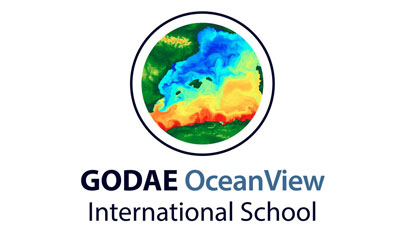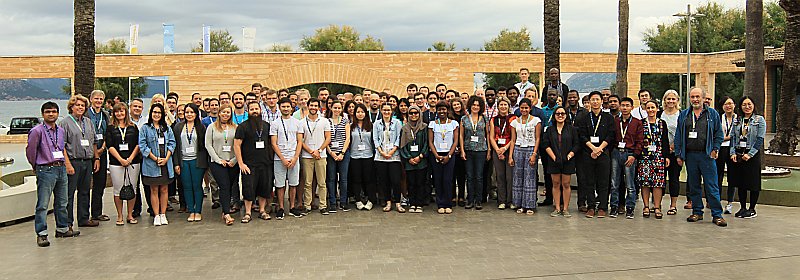
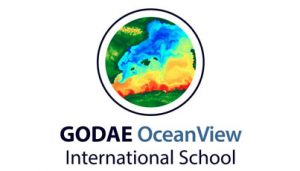 Last week marked the wrap-up of the 2017 GODAE Ocean View International School, hosted in Mallorca, Spain. The summer school, which took place from October 2nd to the 13, is one of the main educational activities supported by GODAE OceanView. During the intense two-week school session, there were 54 lectures, poster sessions, workshops, debates, visit to SOCIB research vessel and hands-on lectures from EUMETSAT and many others. The Mercator Ocean and the Copernicus Marine Service is proud to support this initiative and several speakers from Mercator Ocean contributed this year.
Last week marked the wrap-up of the 2017 GODAE Ocean View International School, hosted in Mallorca, Spain. The summer school, which took place from October 2nd to the 13, is one of the main educational activities supported by GODAE OceanView. During the intense two-week school session, there were 54 lectures, poster sessions, workshops, debates, visit to SOCIB research vessel and hands-on lectures from EUMETSAT and many others. The Mercator Ocean and the Copernicus Marine Service is proud to support this initiative and several speakers from Mercator Ocean contributed this year.

Pierre-Yves Le Traon from Mercator Ocean on geographical coverage of Insitu data
After the two first international summer schools held in Lalonde-Les-Maures (France, 2004) and Perth (Australia, 2010), the 2017 GODAE OceanView School was held in Mallorca (Pollença) under the title « New Frontiers in Operational Oceanography. » The school brings together more than 50 specialists from all over the world, with the aim of demonstrating the latest advances and possibilities in oceanography, cross-platform observation systems, real-time data availability, model integration and assimilation. There were 66 students from 5 continents, and 31 countries. The students were selected based on qualifications (career status, achievements, and motivation) and references. The selection process was highly competitive with over 170 applications from 56 countries. During the training days, lecturers offer practical workshops where international projects and applications are announced, as well provide open spaces for debate.
A direct outcome of the school is a book that will be published shortly after the school finishes in early 2018. The review process happens during the school session and involves the students. They review chapters and give comments and feedback to the lecturers. The book will be translated in several languages. All the lectures and activities have been recorded and will be made available.
Goals of the Summer School this Year
The GODAE OceanView International School 2017, under the title « New Frontiers in Operational Oceanography, » highlights new frontiers, both in terms of scientific challenges and applications to society.
In the coming years, current graduate students and young scientists face many new challenges: Observations (SWOT, Sentinel, AUVs, floats, etc.); complex high resolution numerical models and data assimilation (high resolution, predictability, uncertainty, changing computing platforms, etc.); the need to work on many scales and more and more overlapping with other elements of the Earth system (open ocean-shelf interactions, coupled ocean-ice-atmosphere, biogeochemistry, mesoscale and submesoscale etc.); and the wide range of applications (ecosystem monitoring, climate predictions, oil spill management, shipwrecks rescue, plastic and debris drifts, etc.)
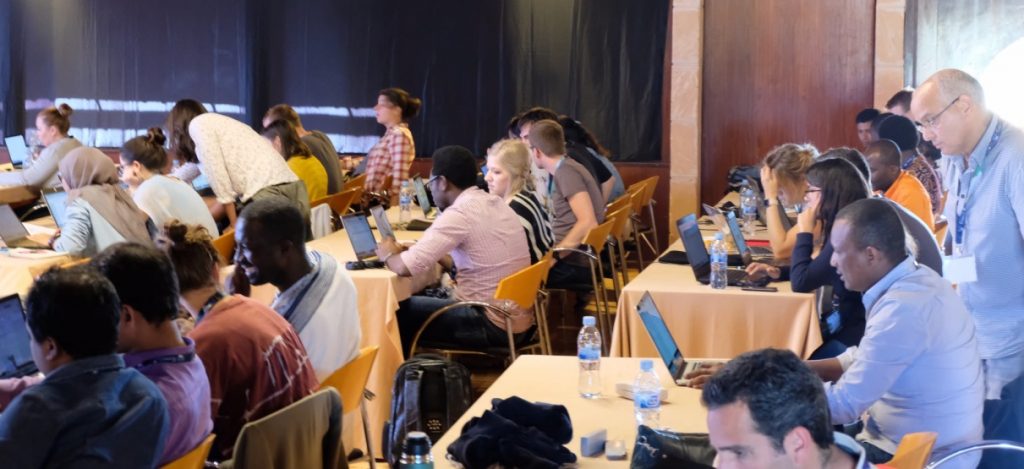
Hands-on CMEMS activity: students with Marie Drevillon, Jonathan Beuvier and Mounir Benkiran from Mercator Ocean
Highlights of this Year
Four specific topics were addressed, namely the coastal ocean areas that are characterized by multiple and interacting scales including open ocean shelf-slope exchanges, the coupled ocean-atmosphere system, ocean biogeochemistry, and the use of new datasets (from the upcoming satellites such as European Sentinels and the upcoming US-French SWOT).
The increasingly international side of Operational Oceanography is also very visible in the school, as seen by the unprecedented attendance of people from the international scientific community. Through EUMETSAT, CMEMS presentations and hands-on activities, this was a special opportunity for the students to actually handle data, tools and pre-operational software.
The study of ocean dynamics is crucial to understanding and predicting climate change. In order to understand the ocean, it is necessary to monitor it and collect all sorts of data. To this end, 21st century oceanographers use the latest advances in oceanography: satellites, in situ measurement instruments, multiplatform campaigns and numerical prediction models.
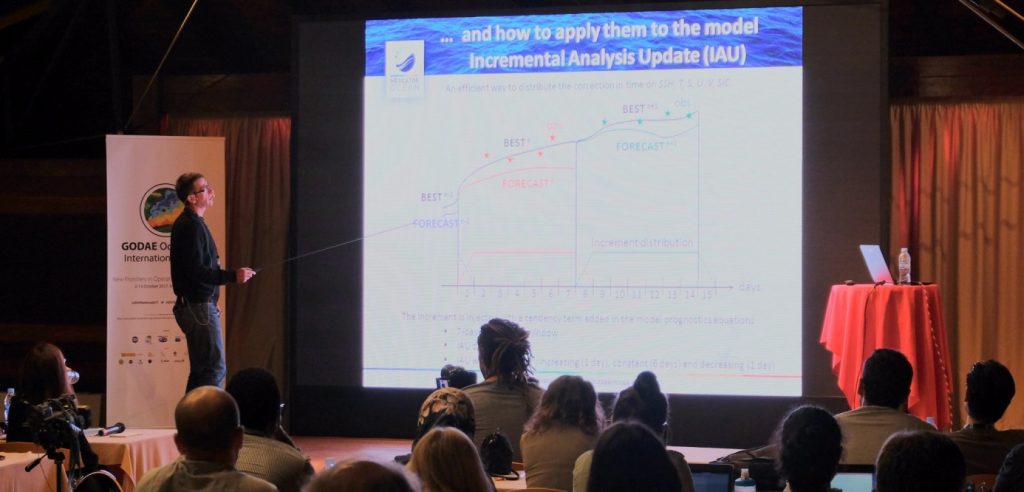
Predictions systems: « System integration » lecture by Jean-Michel Lellouche from Mercator Ocean
The combination of increasingly accurate information from satellites designed for oceanographic research, coupled with the technological development of new observing instruments, has revolutionized and completely changed our ways of studying the sea. In complement to oceanographic missions, new ocean monitoring techniques have emerged using different instruments and technologies, and the systematic use of modelling.
The GODAE OceanView program is open to early career scientists, professionals and students, covering current state of the art methods used in operational oceanography and related advances in the ocean sciences.
GODAE OceanView International School Directors:
- Eric Chassignet, COAPS, Florida State University, Tallahassee, USA
- Ananda Pascual and IMEDEA(CSIC-UIB), Esporles, Mallorca, Spain
- Joaquín Tintoré, SOCIB & IMEDEA (CSIC-UIB), Mallorca, Spain
- Jacques Verron, IGE, Grenoble, France
Sponsors:
– Copernicus Marine Environment Monitoring Service (CMEMS)
– Centre National d’Etudes Spatiales (CNES)
– European Organization for the Exploitation of Meteorological Satellites (EUMETSAT)
– European Space Agency (ESA)
– National Aeronautics and Space Administration (NASA)
– Mediterranean Institute for Advanced Studies (IMEDEA)
– Spanish National Research Council (CSIC)
– University of Balearic Islands (UIB)
– Balearic Islands Coastal Observing and Forecasting System (SOCIB)
– International Laboratory on Global Change (LINCGlobal)
– European Geosciences Union (EGU)
– European Marine Research Network (EUROMarine)
– Scientific Committee on Ocean Research (SCOR)
– PortBlue, Pollença
– International Ocean Carbon Coordination Project (IOCCP)

